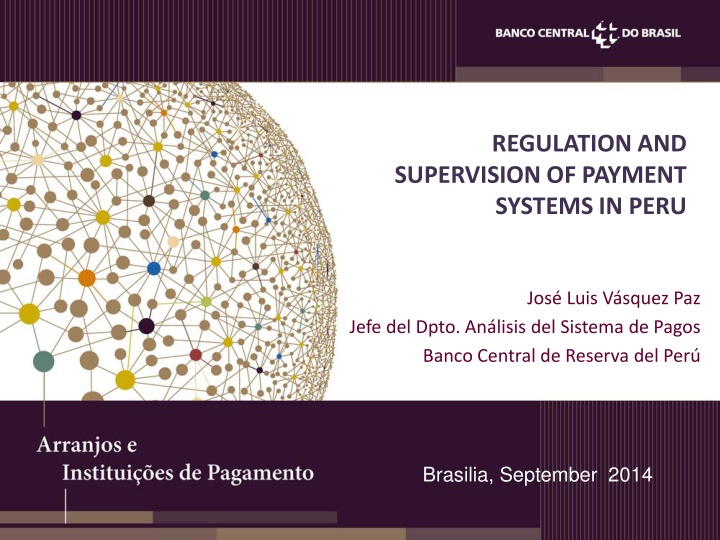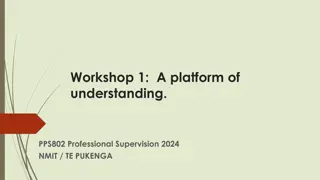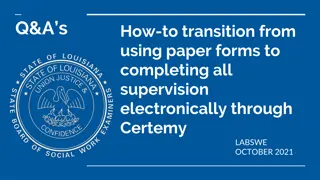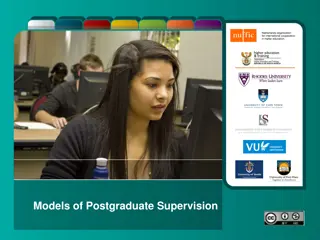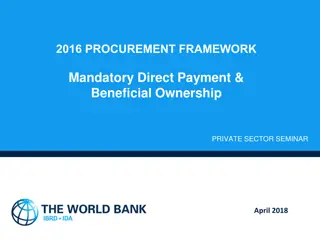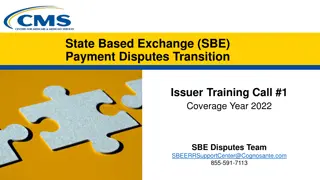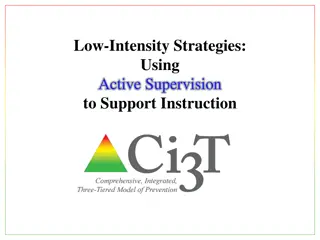Regulation and Supervision of Payment Systems in Peru
Peru has seen significant economic growth and stability from 2004 to 2013, enhancing confidence in the payment system. The Central Reserve Bank of Peru plays a crucial role in ensuring systemic stability, oversight, and efficiency in payment systems. Supervision is necessary to safeguard public objectives as market forces may not always ensure safety and efficiency. Payment systems are vital for monetary policy implementation, and the failure of these systems can impact financial stability. Systemically important payment systems such as RTGS and ACH are closely monitored to uphold national legislation and international standards.
Download Presentation

Please find below an Image/Link to download the presentation.
The content on the website is provided AS IS for your information and personal use only. It may not be sold, licensed, or shared on other websites without obtaining consent from the author.If you encounter any issues during the download, it is possible that the publisher has removed the file from their server.
You are allowed to download the files provided on this website for personal or commercial use, subject to the condition that they are used lawfully. All files are the property of their respective owners.
The content on the website is provided AS IS for your information and personal use only. It may not be sold, licensed, or shared on other websites without obtaining consent from the author.
E N D
Presentation Transcript
REGULATION AND SUPERVISION OF PAYMENT SYSTEMS IN PERU Jos Luis V squez Paz Jefe del Dpto. An lisis del Sistema de Pagos Banco Central de Reserva del Per Brasilia, September 2014
PERU: BACKGROUND PERU LATAM Average Growth (2004 2013) 6.6 4.1 2.9 6.3 Average Inflation (2004 2013) 55 3 Economic growth and price stability enhance confidence in the means of payment, reducing both costs and risks to economic agents. 26 2 -15 -29 Source: International Monetary Fund
THE ROLE OF THE CENTRAL RESERVE BANK OF PERU (BCRP) IN PAYMENT SYSTEMS GOALS FUNCTIONS Systemic Stability Oversight and Supervision Safety Promotion Efficiency User Competition System Operator Inclusion
WHY SUPERVISION? Market forces do not necessarily ensure the public objectives of safety and efficiency. Participants do not always assume all risks and costs associated with clearing and settlement. Factors like economies of scale, barriers to entry, etc. can potentially limit competition and create a dominant market position, which in turn may lead to lower service quality and higher prices.
WHY THE CENTRAL BANK? Payment systems are the basic infrastructure through which money flows across the economy, thereby facilitating the exchange of money for goods, services, and financial assets. They are instrumental in the implementation of monetary policy. A failure in the payment systems can affect the stability of financial firms and markets.
SYSTEMICALLY IMPORTANT PAYMENT SYSTEMS (SIPS) Value Operator Oversight RTGS Large-Value Central Bank Central Bank ACH Low-Value CCE S.A. Central Bank SSS Securities CAVALI Central Bank* (*) Only Fund Settlement. Supported by adequate National legislation (Payment Systems Law and BCRP Circulars) International Standards (Principles BIS)
PAYMENTS HAVE GROWN FASTER THAN GDP Value of Payments/GDP (times) 6.7 6.3 6.2 6.1 5.6 4.9 2008 2009 2010 2011 2012 2013 Source: BCRP
PREFERENCE FOR ELECTRONIC PAYMENTS Operations in ACH Estructura % del volumen de operaciones en la CCE (% share) 100% 90% 80% 70% 60% 50% 40% 30% 20% 10% 0% oct-08 oct-09 oct-10 oct-11 oct-12 oct-13 jul-08 jul-09 jul-10 jul-11 jul-12 jul-13 ene-08 ene-09 ene-10 ene-11 ene-12 ene-13 abr-08 abr-09 abr-10 abr-11 abr-12 abr-13 Cheques Transferencias
TIMELINE 1997 / 1998: Early studies (International Monetary Fund) 2000: Introduction of RTGS and ACH. 2005: Introduction of Securities Settlement System (funds). 2009: Law of the Payment Systems (Law 29440). 2011: New RTGS. 2013 / 2014: New studies (IMF and World Bank)
PILLARS OF THE PAYMENT SYSTEMS LAW Finality. Governance/Transparency. Supervision/Scope and Powers.
PRINCIPLES FOR SUPERVISION Transparency. International standards. - Core Principles (2001): adopted - Principles for FMIs (2012): work in progress Effective powers and capacities. Consistency. Cooperation with other authorities.
SUPERVISION TOOLS Monitoring: is performed by collecting information. Evaluation: Regarding observance of the Law and Bylaws. Induce changes: In case of problems of the administrative agencies, or problems with participants, or the existence of potential for improvement. Inspections on site.
CENTRAL BANK REGULATORY SCOPE CARD PAYMENTS PAYMENT SYSTEMS MONEY TRANSFER OTHERS Networks LBTR (RTGS) Money Transfer Operators E-Money Acquirers CCE (ACH) Telcos Issuers SLMV (SSS) Other Arrangments
FINANCIAL INCLUSION The creation of a Commission to design the National Strategy for Financial Inclusion (ENIF), promotes both greater access and use of quality financial services. The ENIF should promotes financial inclusion through the implementation of coordinated actions (the public and private sectors) in the context of the preservation of financial stability. 15
E- MONEY AS A FINANCIAL INCLUSION TOOL E-Money has the potential to provide access to payment services to a large segment of the population, avoiding the costs and risks of cash. Relies primarily on mobile telephony, which has a wide coverage across populations and regions in the country. Facilitates access to payment services by low-income and/or rural population segments.
E-MONEY LAW Purpose: Regulation of the issuance of e-money and for EEDEs. Definition: e-money is a monetary value as represented by a claim on the issuer: - stored in an electronic medium, - accepted by entities or persons other than the issuer, - issued for an amount equal to the proceeds received, - convertible to cash, - not a deposit and does not accrue interest.
E-MONEY LAW Issuance: Only entities supervised by the Superintendence of Banking, Insurance Companies, and Pension Funds (SBS), including Empresas Emisoras de Dinero Electr nico (EEDEs). EEDEs: -Their main purpose is the issuance of e-money. -May not grant credit against the funds received. -Carry out only operations related to their main purpose. -Required to comply with the provisions on the prevention of money laundering and the financing of terrorism. 18
E-MONEY LAW Consumer protection - Trust fund. - Data protection. - Contracts Telco regulation
BYLAWS Operations Res. SBS 6283-2013 Bank Agents Res. SBS 6285-2013 EEDEs Res. SBS 6284-2013 Authorized operations Authorization Role of bank agents Constitution Simplified accounts Aggregators Prohibition to extend loans Contracts Trusts Prudential measures 20
INICIATIVES IN MOBILE PAYMENTS IN PERU Mobile development) are led primarily by financial companies. payment initiatives (currently at a stage of Mobile Payments - Banks - Using Smartphones or other devices E-Money - Bank and non-bank entities. - Prepay cards (can use also cellphones) - Agent network Platform of E-Money (Bank Association) 21
ECOSYSTEM TOP MED Servicios P blicos Giros y Remesa s BASE Aceptaci n Y Agentes Dispersi n Cr ditos Seguros Tradicional Cooperativa Microfinancieras N minas, Beneficios, Servicios profesionales Micropagos Gobierno Venta Directa Source: Asociaci n de Bancos del Per
PLATFORM Operador 4 Operador 2 Operador 3 Operador 1 Bancos Agentes Financieros Switch Switch Canales ASBANC-Ericsson Wallet Platform ASBANC Wallet Platform Tarjetas de cr dito Channels Switch Switch Red de Agentes Source: Asociaci n de Bancos del Per
FINAL REMARKS Payments international standards and ensures -through a careful supervision- the compliance by the systems administrators with the law and bylaws. systems regulation in Peru follows the Peru has implemented the regulatory framework for E-Money as a tool for financial inclusion. Both regulation and supervision evolve with innovation and new international standards.
